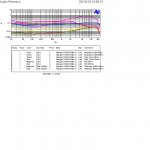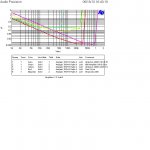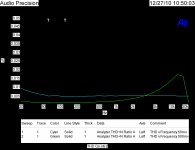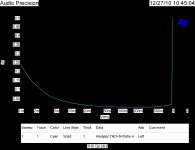I think that it is important for everyone in general, not necessarily the 'critics' here, to understand a little of the physics of electron flow. It is not that it is well defined, at least I can't find any reference that gives a clear understanding, with or without mathematics, but it is important for those who want to keep an open mind, that one knows that some of the approximations such as Drude theory, are just that. Nothing but approximations, and that true current flow, can be quite complex.
Where these approximations work well, is measuring resistance, for example, with an ohm-meter. Calculating the number of electrons/second in a plating tank might be another easy approximation. However, it appears that for audio signal wiring, we still have a lot to learn. So as long as people think that science has proven this impossible, it is difficult to talk about it, and certainly this website is not the place for continued debate on this subject, but those who are open to it should know that it is being worked on by a fair number of researchers, and we will understand it better, in time.
For the moment, I go with what works, or sounds good over a period of time, and that tends to remove a few cables from my listening set-up.
Where these approximations work well, is measuring resistance, for example, with an ohm-meter. Calculating the number of electrons/second in a plating tank might be another easy approximation. However, it appears that for audio signal wiring, we still have a lot to learn. So as long as people think that science has proven this impossible, it is difficult to talk about it, and certainly this website is not the place for continued debate on this subject, but those who are open to it should know that it is being worked on by a fair number of researchers, and we will understand it better, in time.
For the moment, I go with what works, or sounds good over a period of time, and that tends to remove a few cables from my listening set-up.
Last edited:
I think that it is important for everyone in general, not necessarily the 'critics' here, to understand a little of the physics of electron flow.
Why?
It is not that it is well defined, at least I can't find any reference that gives a clear understanding, with or without mathematics...
I = dQ/dt.
1A = 6.242 × 10^18 electrons per second.
Simple.
...but it is important for those who want to keep an open mind...
Keep an open mind about what? That there's something buried in the thermal noise of a piece of wire that we need to worry about?
that one knows that some of the approximations such as Drude theory, are just that. Nothing but approximations, and that true current flow, can be quite complex.
Current flow is quite simple. It's simply the number of electrons passing a given point in a given amount of time.
Where these approximations work well, is measuring resistance, for example, with an ohm-meter. Calculating the number of electrons/second in a plating tank might be another easy approximation. However, it appears that for audio signal wiring, we still have a lot to learn.
Appears?
Based on what exactly?
Some completely vague "gut feeling"?
What?
So as long as people think that science has proven this impossible, it is difficult to talk about it, and certainly this website is not the place for continued debate on this subject, but those who are open to it should know that it is being worked on by a fair number of researchers, and we will understand it better, in time.
"It"? What "it"? You mean the hitherto unknown and undefined phenomenon that's hiding below the thermal noise of the wire?
se
I said that the problem had been solved, not once but many times. When I shop for amplifiers, I shop specs and price. I don't buy tube amplifiers and I don't buy oddball audiophile type equipment. I buy mainstream cost effective equipment of proven reliability.
Good for you. I'm not as fortunate as you. I find that sound quality isn't correlated to the specifications published by manufacturers. Therefore I shop for sound quality, not for specifications, which costs me a lot of money.
What impresses me is that so many people who do not believe in serious differences in audio reproduction have very strong views against others who do.
Indeed, an interesting phenomenon.
Keep an open mind about what?
Maybe about the (audible) fact that different interconnect cords have different sound signature. The same goes for power cords, power distribution boxes and so on.
I think that it is important for everyone in general, not necessarily the 'critics' here, to understand a little of the physics of electron flow. It is not that it is well defined, at least I can't find any reference that gives a clear understanding, with or without mathematics, but it is important for those who want to keep an open mind, that one knows that some of the approximations such as Drude theory, are just that. Nothing but approximations, and that true current flow, can be quite complex.
Where these approximations work well, is measuring resistance, for example, with an ohm-meter. Calculating the number of electrons/second in a plating tank might be another easy approximation. However, it appears that for audio signal wiring, we still have a lot to learn. So as long as people think that science has proven this impossible, it is difficult to talk about it, and certainly this website is not the place for continued debate on this subject, but those who are open to it should know that it is being worked on by a fair number of researchers, and we will understand it better, in time.
For the moment, I go with what works, or sounds good over a period of time, and that tends to remove a few cables from my listening set-up.
I'm not a believer in magic. I once asked you if you had a working definition of what an ideal amplifier should do. You didn't have an answer at that time. I hope you've had a chance to reflect on it.
I don't know or care what people mean when they say this amplifier or this wire sounds better than that one. To me these devices have a specific function to perform. That function is clearly defined. If they perform it correctly, accurately to where their deviation from their ideally performed function is less than the limits of audibility, then any problem with the results lies elsewhere. Whether a shortcoming in one component mitigates a shortcoming of another doesn't interest me. That a vacuum tube amplifier with a rolled off high end or a wire with high shunt capacitance will compensate for a shrill loudspeaker system does not make it preferable. There are far better ways to correct the problem including replacing the defective speaker system. What you like in one sound system or another is not an objective reason for me to buy it or even accept what you say. Not unless you have measurements and facts to back up its superiority.
" However, it appears that for audio signal wiring, we still have a lot to learn."
I don't understand what you mean. Whether we have knowledge of how electrons flow or not, we have the means to measure current and voltage waveforms on an oscilloscope and analyze them with a computer to great accuracy and precision. We can find out what is happening even if we don't know the precise mechanism of how it happens. Your position is that there is an unidentifiable magical element of which you (metaphorically) are the judge with the expert knowledge who can guide us through the wilderness of the unknown to audio nirvana. T'ain't so. At least I don't accept it. Not until you have scientific facts to back it up. So far it seems to me you don't even have a theory to explain why one of your designs is better than another.
Good for you. I'm not as fortunate as you. I find that sound quality isn't correlated to the specifications published by manufacturers. Therefore I shop for sound quality, not for specifications, which costs me a lot of money.
My reference standard is live music. I am fortunate to have had continual access to it all of my life. I can hear live music in my home every day. I've been to countless concerts too. Clearly I have my own ideas about designing and building sound systems to reproduce what I hear live. I rarely venture into the market to hear the latest best efforts of others anymore, they always fall far short of their advertising buildup and invariably disappoint.
If I have a problem with specifications, it is the way equipment is measured. For example with audio amplifiers, due to historical reasons, their FR is measured at one watt into an 8 ohm resistive load. In the 1920s and 1930s this measurement showed real differences between designs. But by the 1960s, those differences had disappeared with these measurements. Had they measured FR at full rated power and every power level below into reactive loads and even into non passive loads like real loudspeakers, differences in measurements would have emerged that would have shown the audible differences in performance. Concepts like TIM and slew rate would be superfluous because they would have shown up as limitations to full power FR with real loads, similar to the concept of gain power bandwidth product. Nevertheless, the best designs for professional use, not the audiophile designs would likely today come off best. As for measurements for loudspeakers, they are all but worthless. If there is something to learn, it is how to make meaningful measurements.
My reference standard is live music.
You must be very disappointed.
If you think for one minute you can accurately, by any measure, reproduce in your listening room, say Tommy Aldridge on his custom Yamaha double kick drum kit you're fooling yourself. You couldn't even come close.

Scott,
A while back I started on a project to test to see if resistor differences are as important as some claimed.
I had left over from an article an Ampslab LM-60 amplifier. When I measured it for the article I got these results. Note that it was the best performing amplifier of the group.
I then modified it by replacing all of the inexpensive metal film (MF) resistors with ones I had thought were better. I reduced the value of the output resistor in the final RC filter. There were two electrolytic capacitors bypassed by a small film resistor in the ground side of the feedback path to lower DC gain to unity. These were replaced by a pair of moderate quality film capacitors of much smaller value.
The output bias was increased to improve high frequency distortion near clipping. The power supply was slightly modified by adding two diode drops to the positive rail supply. 30uf Film capacitors were added from each rail to ground.
The feedback resistor was removed. A Lorlin shorting rotary switch allowed selection of either a high quality MF resistor or the second worse Carbon Composition unit. (The worst I measured is now out of production)
I was quite surprised by how much better the amplifier measured with these changes.
A while back I started on a project to test to see if resistor differences are as important as some claimed.
I had left over from an article an Ampslab LM-60 amplifier. When I measured it for the article I got these results. Note that it was the best performing amplifier of the group.
I then modified it by replacing all of the inexpensive metal film (MF) resistors with ones I had thought were better. I reduced the value of the output resistor in the final RC filter. There were two electrolytic capacitors bypassed by a small film resistor in the ground side of the feedback path to lower DC gain to unity. These were replaced by a pair of moderate quality film capacitors of much smaller value.
The output bias was increased to improve high frequency distortion near clipping. The power supply was slightly modified by adding two diode drops to the positive rail supply. 30uf Film capacitors were added from each rail to ground.
The feedback resistor was removed. A Lorlin shorting rotary switch allowed selection of either a high quality MF resistor or the second worse Carbon Composition unit. (The worst I measured is now out of production)
I was quite surprised by how much better the amplifier measured with these changes.
Attachments
You must be very disappointed.
If you think for one minute you can accurately, by any measure, reproduce in your listening room, say Tommy Aldridge on his custom Yamaha double kick drum kit you're fooling yourself. You couldn't even come close.

I woudn't know, I've never heard him live. My interest run more in the line of Steinway pianos, and Stradivarius and Guarneri violins.
On another blog site, I've been informed by people who were there at the factory where the event took place that in an LvR comparison between the drummer Buddy Rich and an AR 10pi, the speakers did quite well. Very little audible difference.
My reference standard is live music.
This is also my reference.
I woudn't know, I've never heard him live. My interest run more in the line of Steinway pianos, and Stradivarius and Guarneri violins.
On another blog site, I've been informed by people who were there at the factory where the event took place that in an LvR comparison between the drummer Buddy Rich and an AR 10pi, the speakers did quite well. Very little audible difference.
I've been fortunate to have two classically trained professional musicians in my family. One of whom was first chair for the San Francisco Symphony. I've heard them play on many occasions.
Well then surely you can imagine a Steinway piano in your listening room. How does what you hear through your hi-fi compare to that?
With just a simple explanation of a sound wave hitting your face versus one hitting a 1/2" diaphram and then being reproduced; one can see the problem with using live music as a reference.
I won't even go in to room acoustics, mic. type, make, position, recording equipment, recording personnel, recording format, mastering, editing, mixing, personal performances........etc.
Maybe about the (audible) fact that different interconnect cords have different sound signature.
I'm sorry, but that has yet to be established as fact.
se
Here are the after modification curves, note the scale has changed!
If I didn't see the clipping distortion I would have thought I forgot to hook up the amplifier!
I did not expect such a dramatic change or else I would have taken measurements after each change, instead of just doing it all at once.
I then tried to see if I could hear a difference between the two types of feedback resistors.
If I didn't see the clipping distortion I would have thought I forgot to hook up the amplifier!
I did not expect such a dramatic change or else I would have taken measurements after each change, instead of just doing it all at once.
I then tried to see if I could hear a difference between the two types of feedback resistors.
Attachments
replacing resistors with ones I had thought were better.
Mr Simon,
how vague you are. Act of diplomacy ?

Scott,
A while back I started on a project to test to see if resistor differences are as important as some claimed.
I had left over from an article an Ampslab LM-60 amplifier. When I measured it for the article I got these results. Note that it was the best performing amplifier of the group.
I then modified it by replacing all of the inexpensive metal film (MF) resistors with ones I had thought were better. I reduced the value of the output resistor in the final RC filter. There were two electrolytic capacitors bypassed by a small film resistor in the ground side of the feedback path to lower DC gain to unity. These were replaced by a pair of moderate quality film capacitors of much smaller value.
The output bias was increased to improve high frequency distortion near clipping. The power supply was slightly modified by adding two diode drops to the positive rail supply. 30uf Film capacitors were added from each rail to ground.
The feedback resistor was removed. A Lorlin shorting rotary switch allowed selection of either a high quality MF resistor or the second worse Carbon Composition unit. (The worst I measured is now out of production)
I was quite surprised by how much better the amplifier measured with these changes.
IMO, if this is a class AB push pull amplifier, output bias should be adjusted to minimize crossover notch distortion. This may be reflected in what seems like high THD at low output, increasing as output is lowered. THD should get lower or stay about the same as output is reduced. This was a very common characteristic of early solid state amplifiers. Their harsh sound was attributed to this flaw in their design.
If you think for one minute you can accurately, by any measure, reproduce in your listening room, say Tommy Aldridge on his custom Yamaha double kick drum kit you're fooling yourself. You couldn't even come close.
Completely agreed. And running source directly into a power amp (i.e., a "perfect" preamp) won't bring you an iota closer. The issues are elsewhere.
IMO, if this is a class AB push pull amplifier, output bias should be adjusted to minimize crossover notch distortion. This may be reflected in what seems like high THD at low output, increasing as output is lowered. THD should get lower or stay about the same as output is reduced. This was a very common characteristic of early solid state amplifiers. Their harsh sound was attributed to this flaw in their design.
Note I use asymetric voltage rails. Just looking at low level THD or IM has other issues. In the old days I used to use headphones and just a very low level for the best sound. Then set the trim in the middle of my did not hear a difference zone.
So we generally agree on this point.
Last edited:
- Status
- Not open for further replies.
- Home
- Member Areas
- The Lounge
- John Curl's Blowtorch preamplifier part II



